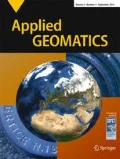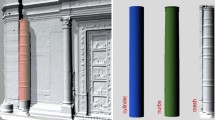Abstract
The present paper analyses the Abbey of S. Matteo in Genoa exemplifying a possible use of survey and its elaborations in the field of conservation. The three-dimensional survey was used as the basis for the collection, management and representation of the data derived from the survey on rising damp. The purpose was to test a dynamic data processing system that could be used as a tool to collect data on site as well as to access data remotely. By using software for three-dimensional representation and a node programming language, it was possible to define a system that offered dynamic viewing and was easy to use, through the use of chromatic scales and level curves, which can be generated starting from tables containing numerical data. Surveying, diagnostics, modelling and representation allow one to experiment with new ways of interaction within the common goal of conservation.


















Similar content being viewed by others
Notes
According to the agreement between the Parish of S. Matteo (Mons. G.C. Rapallo) and Ecodry Italia Srl (Mr. R. De Rosa), after 3 years of monitoring—which would have given visibility to the operation and at the same time would have allowed the appointed institutions to directly control the procedures—the Parish would have either bought the equipment in the event it proved successful or otherwise returned it.
The Superintendence for Cultural and Landscape Heritage Liguria (from 2016 Superintendence Archaeology, Cultural Heritage and Landscape for Liguria) appointed as its project representative, the area representative at the time, Arch. G. Peirano (substituted by Arch. C. Arcolao in 2016); the Curia appointed as its representative, Dr. M.G. Di Natale from the Ecclesiastic Cultural Heritage and Sacred Art Office; the Order of Architects appointed as its representative, the councillor for restoration (Arch. G. Peirano until 2013); the University, involved in the project as Department of Sciences for Architecture (from 2016 Architecture and Design Department) appointed as scientific supervisors Prof. S. F. Musso and Prof. R. Vecchiattini.
The monitoring activities were carried out simultaneously and independently by Ecodry Italia and the University, under the supervision of both Superintendence and Curia. During the agreed upon days for monitoring, measurements were taken independently by both parties in the same points with different equipment.
Non-destructive method that measures the electrical resistance of a material which diminishes in relation to the quantity of water contained in it (Protimeter Mini e Protimeter Surveymaster).
Non-destructive method that measures the dielectric constant of a given material which sensibly increases even with small quantities of water (GANN BL compact B e Protimeter Surveymaster).
Destructive method that measures the quantity of water in a material sample, which is weighed immediately after having been taken and after having dried with a thermoscale (Kern DLB).
This is one of the limitations of the work, because it would have been useful in these 4 years to have had environmental data—outside the church (in the opposite square and in the adjacent cloister) and inside the church (in the hall, the crypt and in the space underneath the crypt)—in order to better understand the condensation phenomena which seemed to be particularly pronounced in the church of S. Matteo.
The use of the phase-variation scanner, because of the technology used, guarantees a measurement accuracy below 2/3 mm. While the scanner is highly precise, it has, however, a limited working range, which, in the case of the equipment used, is 79 m.
Grasshopper is a free visual editor for scripting which does not require programming notions. Through an intuitive graphic method based on node interface, the user can define sequences of instructions that will be translated into three-dimensional models in the Rhinoceros window. The modelling process is implemented with algorithms and operations allowing the calculation of a desired result starting from input data with a logic and finite sequence of elementary instructions.
The non-uniform rational basis-spline (NURBS) are a mathematical model used to define curves, surfaces and solids.
References
Battini C, Sorge E (2016) Dynamic Management of Survey data and Archaeological Excavation. The case study of the Amphitheatre of Volterra. SCIRES-IT-Sci Res Inf Technol 6(2):119–132
Calderini C, Vecchiattini R, Battini C, Piccardo P (2016) Mechanical and metallographic characterization of iron tie-rods in masonry buildings: an experimental study. In Proceedings of 10th International Conference on Structural Analysis of Historical Constructions, 13/15 Settembre Leuven (Belgium), pp tot. 8
Camuffo D, Bertolin C (2012) Towards standardisation of moisture content measurement in cultural heritage materials, in E-preservation. Science 9:23–35
Capitani D, Proietti N, Gobbino M, Soroldoni L, Castellano U, Valentini M, Rosina E (2009) An integrated study for mapping the moisture distribution in an ancient damaged wall painting. Anal Bioanal Chem 394:2245–2253
D’Oria S, Gadducci S (2005) San Matteo. La chiesa, la piazza, i palazzi. Genova: SES
Doneus M, Neubauer W (2005) 3D laser scanners on archaeological excavations. In Proceedings of CIPA 2005 XX International Symposium, Torino, Italy, 26 September–1 October 2005; Volume 34(5/C34/1), pp 226–231
El-Hakim S, Gonzo L, Voltolini F, Girardi S, Rizzi A, Remondino F, Whiting E (2007) Detailed 3D modelling of castles. Int J Architect Comput 5:199–220
Guidi G, Remondino F (2012) 3D Modelling from real data. In Modeling and simulation in engineering, edited by C. Alexandru, InTech, pp 69–102
Nady M, Saïd A (2007) Measurement methods of moisture in building envelopes—a literature review. Int J Archit Herit 1:293–310
Oreni D, Brumana R, Della Torre S, Banfi F, Barazzetti L, Previtali M (2014) Survey turned into HBIM: the restoration and the work involved concerning the Basilica di Collemaggio after the earthquake (L’Aquila). In ISPRS Annals of the Photogrammetry, Remote Sensing and Spatial Information Sciences, Volume II-5, 2014 ISPRS Technical Commission V Symposium, 23–25 June 2014, Riva del Garda, Italy, pp. 267–273
Park J, Wang TH, Witt A, Loftness V (2013) Data acquisition and visualisation for IEQ assessment: a case study of daylight field measurement, Proceedings of 29th Conference Sustainable Architecture for a Renewable Future, PLEA2013, Munich Germany, pp tot 5
Peron F, Grinzato E, Gava M (2010) The environmental and anthropogenic hazards of monuments visualisation procedure by IR thermography and numerical modelling. In Proceeding of 8th MONUBASIN Symposium 2010, May 31st–June 2nd, Patras, Greece
Rinaudo F, Agosto E, Ardissone P (2007) GIS and Web-GIS, commercial and open source platforms: general rules for cultural heritage documentation. XXI International CIPA Symposium, 01–06 October, Athens, Greece
Russo M, Remondino F, Guidi G (2011) Principali tecniche e strumenti per il rilievo tridimensionale in ambito archeologico. In Archeologia e Calcolatori, 22, pp 169–198
Şasi A, Yakar M (2018) Photogrammetric modelling of Hasbey Dar'Ülhuffaz (Masjid) using an unmanned aerial vehicle. Int J Eng Geosci 3(1):6–11
Seker DZ, Alkan M, Kutoglu SH, Akcin H, Kahya Y (2010) Development of a GIS based information and management system for cultural heritage site; Case study of Safranbolu. FIG Congress 2010, Facing the Challenges – Building the Capacity, Sydney, Australia, 11–16 April
Tommasi C, Achille C, Fassi F (2016) From point cloud to BIM: a modelling challenge in the cultural heritage field. In The International Archives of the Photogrammetry, Remote Sensing and Spatial Information Sciences, Volume XLI-B5, 2016 XXIII ISPRS Congress, 12–19 July 2016, Prague, Czech Republic, pp. 429–436
Yilmaz HM, Yakar M, Gulec SA, Dulgerler ON (2007) Importance of digital close-range photogrammetry in documentation of cultural heritage. J Cult Herit 8:428–433
Yilmaz HM, Yakar M, Yildiz F, Karabork H, Kavurmaci MM, Mutluoglu O (2009) Monitoring of corrosion in fairy chimney by terrestrial laser scanning. J Int Environ Appl Sci 4(1):86–91
Acknowledgements
The authors would like to thank Mons. G. C. Rapallo and Arch. S. Crocco from the Parrocchia di S. Matteo; R. De Rosa and the Ecodry Italia technicians for their precious cooperation; R. Lavezzaro, R. Babbetto, G. Rosatto and A. Orefice for their work on site; Arch. A. Decri from Ipsilon Coop pscrl for sharing several diagnostic tools.
Author information
Authors and Affiliations
Corresponding author
Rights and permissions
About this article
Cite this article
Battini, C., Vecchiattini, R. Data parametric representation for monitoring of cultural heritage. Appl Geomat 10, 191–204 (2018). https://doi.org/10.1007/s12518-018-0219-1
Received:
Accepted:
Published:
Issue Date:
DOI: https://doi.org/10.1007/s12518-018-0219-1




